Yoshindo Yoshihara. Pace & precision
Progress is not neutral. What is crucial to true progress is a sense of proportion, a pace that is appropriate to human beings, and the right sequence of steps in the progression that leads from a project to a product.
At bulthaup, those senses of proportion, pace, precision, and expert craftsmanship are key values. And that is why we were fascinated by the skill of Japanese swordsmith Yoshindo Yoshihara, an example of the quest for human precision.
As far back as I can remember, I’ve wanted to be a swordsmith like my grandfather Kuniie. I spent my entire childhood in his workshop (or rather, my entire life, because I am still working there today). Like all boys, I was of course fascinated by the world of the samurai and the myths surrounding their swords, which made their bearers invincible. I was extremely impressed by the fact that such magical weapons came from grandfather’s workshop, even though by then the samurai warriors were of course a thing of the past and the sword as the classic Japanese martial weapon had become obsolete.
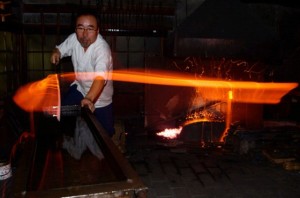 What fascinated me the most in my grandfather’s workshop was the fire in which the swords were created–the flames, the blaze and the colors. This fire still fascinates me, because I know that it ultimately determines how close a sword blade will come to perfection. Perhaps the crucial skill of a good swordsmith is the ability to correctly estimate and control the temperature of the charcoal fire. That’s because the smiths who make traditional Japanese swords do not use ready-made industrial steel. We make our steel ourselves; that is, we process the “tamahagane”–the raw steel that all of us get from the only traditional steel foundry in Japan–ourselves. In this elaborate smelting process, the carbon contained in the iron ore is transformed, and it’s this carbon component that determines the hardness of the steel and the quality of the sword blade. Here, precision is of the essence. If you let the fire get too hot, you produce soft and brittle steel that is useless for making a good sword blade. If you keep the temperature too low, you risk getting cracks in the steel, and here too you’ll produce an inferior blade.
What fascinated me the most in my grandfather’s workshop was the fire in which the swords were created–the flames, the blaze and the colors. This fire still fascinates me, because I know that it ultimately determines how close a sword blade will come to perfection. Perhaps the crucial skill of a good swordsmith is the ability to correctly estimate and control the temperature of the charcoal fire. That’s because the smiths who make traditional Japanese swords do not use ready-made industrial steel. We make our steel ourselves; that is, we process the “tamahagane”–the raw steel that all of us get from the only traditional steel foundry in Japan–ourselves. In this elaborate smelting process, the carbon contained in the iron ore is transformed, and it’s this carbon component that determines the hardness of the steel and the quality of the sword blade. Here, precision is of the essence. If you let the fire get too hot, you produce soft and brittle steel that is useless for making a good sword blade. If you keep the temperature too low, you risk getting cracks in the steel, and here too you’ll produce an inferior blade.
One special characteristic of the traditional Japanese sword is the fact that different areas of the blade have different degrees of hardness. The main body of the blade is softer, and that makes it elastic. The cutting edge is hard, which makes it sharp and indestructible. The process of “yakiire”- which means “holding the iron in the fire”–requires the greatest possible precision. You can’t measure the temperature of the fire while you’re working. Only on the basis of the color of the flame, which can range from a “cool” cherry red to a very hot light yellow, can you gauge whether you have reached the ideal temperature of 800 degrees. In Japan we say that this is the moment when the sword comes alive. And that’s why swords are created in rooms that are almost totally dark–it’s so that the smith can see the flame with absolute clarity.
The most striking physical quality of the sword, and its most important aesthetic aspect, is its “hamon.” This is the clearly visible patterning or grain on the blade that shows the line of hardness along the cutting edge. The “hamon” is what gives a sword its individual character. A clearly visible “hamon” indicates a very sharp and effective blade. This patterning arises only in the fire, not through hammering. To create it, I pull the sword out of fire, cover parts of it with layers of clay of varying thickness and let it dry for a while. Then I carefully pull the sword through the fire several times and finally plunge the red-hot sword into cold water. Depending on the length of time it takes for the steel to cool off, different kinds of lines and surface structures are generated. These become visible for the first time when the sword is pulled across a water-cooled grindstone. If everything goes according to plan, the “hamon” lines look just like the ones I imagined while I was putting on the layers of clay. If a “hamon” does not measure up to my expectations, I can repeat the entire hardening process a few more times. No matter how carefully I carry out the process, this repetition can’t always be avoided, although I naturally try to make the blade perfect the first time around. Sword experts can tell from a “hamon” which swordsmith created the weapon in question, and of course I also immediately recognize the swords I have made. Every individual swordsmith has his own techniques, and the master craftsmen never reveal how they work. That always remains a professional secret.
I can’t remember exactly when I first had the feeling, “I’ve now reached the point where I know how to forge a perfect sword.” I simply acquired the necessary skills as the years went on, and at certain point that feeling was there. I think it helps a lot if a swordsmith has had first-hand experience ever since his childhood, as I did, of what swordsmithing is all about. I guess I was already a swordsmith in my heart even before I started my apprenticeship, together with my younger brother Shoji, in my grandfather’s smithy.
Precision and careful workmanship are the most important elements of our craft. But my kind of precision is completely different from that of a pianist, for example. If a pianist has spent a year without practicing or working on his technique, he’ll be in serious trouble. But if I let a year go by without forging a sword, I don’t lose any of my skills. At the end of that year I can once again create a perfect sword. The precision I’ve gradually gained over the years is something I will never lose. I can summon it whenever I need it. All the same, I will never be able to create two identical swords, nor would want to. The fascination of my craft lies precisely in the fact that every sword is unique.
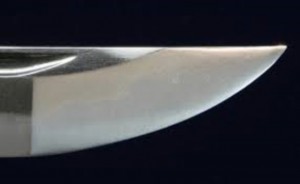 I don’t know whether a good swordsmith is born, not made. It’s a craft, and I suppose anyone can learn it if he’sclever with his hands. In our family, there have been four generations of swordsmiths. As for me, I never considered any other profession. My son Yoshikazu, who was born in 1967, is continuing the family tradition. He did his apprenticeship with me. And now he’s very successful, which of course makes me proud. Nonetheless, I don’t really regard myself as a teacher. The young people who work with me have to find out the tricks of the trade all by themselves. I don’t think they can learn to make a good sword simply by watching me. And things like precision cannot be taught at all.
I don’t know whether a good swordsmith is born, not made. It’s a craft, and I suppose anyone can learn it if he’sclever with his hands. In our family, there have been four generations of swordsmiths. As for me, I never considered any other profession. My son Yoshikazu, who was born in 1967, is continuing the family tradition. He did his apprenticeship with me. And now he’s very successful, which of course makes me proud. Nonetheless, I don’t really regard myself as a teacher. The young people who work with me have to find out the tricks of the trade all by themselves. I don’t think they can learn to make a good sword simply by watching me. And things like precision cannot be taught at all.
It may sound odd coming from a passionate swordsmith, but I don’t have a collection of my own weapons, I never keep a sword I‘ve made, even if it’s a masterpiece. I’m not a collector, I’m a craftsman who makes swords for collectors, swords that are as close to perfection as possible. So I have a very pragmatic and unsentimental attitude toward my work. Nor do I feel like an artist, and certainly don’t feel like an artist who surrounds himself with his own works. In my opinion, artists who collect their own works usually do so because they can’t sell them.
My swords cost between three and four million yen, which amounts to 24,000-32,000 euros. That sounds like a lot of money, but a great deal of time and work goes into each sword. And I make only about ten swords a year. If all goes well, it takes me about a week to make a blade. And then are also the other craftsmen who work on a sword, such as the polisher, the ferrule maker and the scabbard maker. But as the smith who makes the blade, I supervise everything. And I’m the one who makes the final review of a finished sword and hands it over to the client.
Some critics say that swordsmiths of today are only interested in the aesthetics of a sword rather than its functions as a weapon. But I think that these aspects cannot be separated. The better a sword functions, the more beautiful it is as well. A particularly good balance and an ideal curve along the blade are the indicators of not only the highest quality but also of outstanding beauty. Modern swordsmiths have improved both the sword itself and its beauty by bringing its practical qualities to a state of perfection. If a sword has a good curve, then the balance is right too. A sword that has a beautiful “hamon” is of high quality, and the best possible quality leads to perfect beauty.
YOSHINDO YOSHIHARA was born in Tokyo in 1943 and has been a licensed swordsmith since 1965. Yoshihara is recognized as one of the great masters of his craft, which is practiced today by only about 250 people in all of Japan. He continues to work in the old smithy that was used by his grandfather, located in a traditional neighborhood in the northern part of the city. Yoshihara has been honored with every prize awarded in his strictly regulated craft. In 1973, for example, he was the first person to receive the newly established Prince Takamatsu. In 1982, he was named a “mukansa”, thus receiving the highest possible honor a swordsmith can aspire to. This distinction means that he is permitted to participate in all exhibitions and competitions without first having to submit his work to a selection committee. Works by Yoshihara were also bought by U.S. museums in the 1980s, and can now be seen in the Metropolitan Museum of Art in New York City and the Boston Museum of Art. Since 1991, Yoshindo Yoshihara has been a member of the important Cultural Assets Council at the Agency for Cultural Affairs, which is part of the Japanese Ministry of Culture.

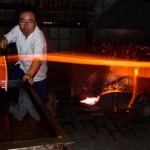
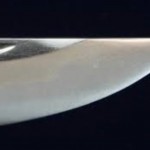

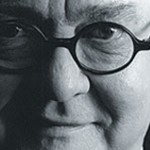
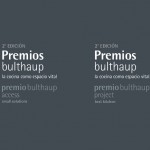


This entry has 0 Comments